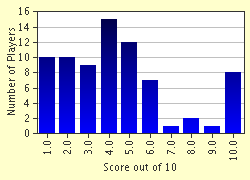Quiz Answer Key and Fun Facts
1. The first translucent porcelain produced in England was which?
2. I have been accused of buying the closing Bow establishment and converting it into a turpentine factory, but I won't tell you whether that's correct or not. What I can tell you is that I established a very successful factory in Derby and later acquired the Chelsea works as well. My name was...
3. I developed a porcelain formula which my partner William Miller and I manufactured in Bristol for a short time before 1752. Unfortunately, we never had any commercial success with it. My name was...
4. I was a Quaker chemist who became so interested in making porcelain that for a time I was importing clay from North America! Fortunately, I was able to find the same type of material closer to home, in Cornwall. Using this, I made the first true hard-paste formula (very similar to Chinese porcelain) in England. My name was...
5. My name is associated with Derby, Pinxton, Mansfield, Torksey, Brampton, Worcester, Swansea, Nantgarw, and Coalport. Although I started out painting flowers, I dreamed of producing the most translucent and exquisite porcelain ever. My name was...
6. Among the many ingredients tested for a porcelain body were powdered glass, powdered Chinese porcelain, and powdered calcined bone. All of these additives proved useful, but the resulting porcelain was always too fragile or too hard to work with. One day, or so the story goes, I was out of burnt bone and dumped in powdered fresh animal bone instead. The result? I had a beautiful white porcelain that was easy to model and held its shape well when fired. The glaze resisted cracking even when boiling water was poured over it. It was even comparatively tough and unlikely to shatter when accidentally tapped with a fork or spoon. My name was...
7. Although my firm was part of the group of ten potters who purchased the New Hall porcelain works, thus making possible its continued existence, I was no doubt a bane to the English porcelain industry. During my career, I perfected a light, tough, creamy pottery that made it possible for families of modest means to own beautiful tableware. Even Queen Charlotte bought a set and permitted me to call it Queensware. I also developed the finest-grained stoneware ever, capable of being colored throughout and needing no painting or glaze to enhance it. My name was...
8. Which of these talented artists is not renowned for his paintings on porcelain?
9. Which company did business as Flight from about 1783, changing to Flight & Barr in 1793, to Barr, Flight & Barr in 1807, and to Flight, Barr & Barr about 1813? `
10. Which factory was credited with producing the immense quantity of porcelain imported from China?
Source: Author
ragiel
This quiz was reviewed by FunTrivia editor
ozzz2002 before going online.
Any errors found in FunTrivia content are routinely corrected through our feedback system.


